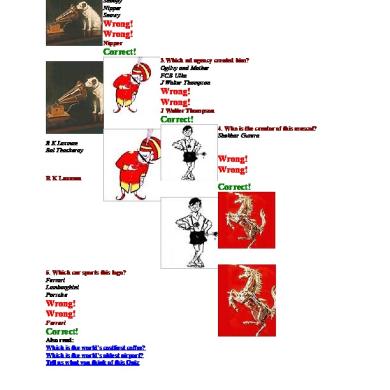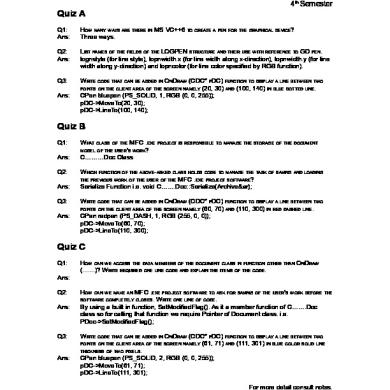(12)answers To Quiz 12.doc
This document was uploaded by user and they confirmed that they have the permission to share it. If you are author or own the copyright of this book, please report to us by using this DMCA report form. Report DMCA
Overview
Download & View (12)answers To Quiz 12.doc as PDF for free.
More details
- Words: 1,165
- Pages: 5
Answers to the questions in Quiz 12: 1. Explain how the long-run differ from the short-run when it comes to money neutrality. Answer:
The classical theory or the quantity theory of money describes the world in the long-run but not in the short-run.
In the long-run (beyond a period of several years), changes in the money supply affect prices and other nominal variables, but do not affect real GDP, unemployment, or other real variables.
In the short-run, most real and nominal variables are intertwined. Changes in the money supply affect both nominal variables (like prices) and real variables (including real GDP, unemployment, or other real variables).
2. What is the definition of a boom? What is the definition of a recession? Answer:
Recession is a period of declining real income and rising unemployment. During periods of recession, real GDP and other measures of income, spending, and production fall (and unemployment rises).
Boom is a period of rising real incomes and falling unemployment. During periods of boom, real GDP and other measures of income, spending, and production rise (and unemployment falls).
3. Define the aggregate demand (AD) curve. Define the aggregate supply (AS) curve. Answer:
The aggregate demand curve shows the quantity of goods and services that households, firms, and the government want to buy at each price level.
The aggregate supply curve shows the quantity of goods and services that firms choose to produce and sell at each price level.
At the equilibrium, aggregate demand equals aggregate supply: AD = Y (= output)
1
4. Explain why the aggregate demand curve is negatively sloped by describing the wealth effect, the interest rate effect, and the exchange rate effect. Answer: The aggregate demand curve slopes down because of the wealth effect, the interest rate effect and the exchange rate effect:
The wealth effect focuses on the relationship between the price level and consumption:
A decline in the price level makes households feel wealthier which, in turn, encourages them to increase their demand for consumer goods and services.
The increase in consumer spending increases the aggregate demand.
Firms respond to this increase in aggregate demand by increasing output (Y). That is, when P declines, Y increases: P
C
AD
Y
The interest rate effect focuses on the relationship between the price level and investment:
A decline in the price level means that people need less money to hold for transaction purposes (for buying goods and services).
This means that when the price level falls, people try to reduce their holdings of money (or their demand for money) by saving and lending some out in the financial system.
Due to this increase in saving, the supply curve in the market for loanable funds shifts to the right. As a result, the interest rate falls.
Lower interest rate encourages borrowing by firms to invest in new plants and equipment.
The increase in investment spending increases the aggregate demand.
Firms respond to this increase in aggregate demand by increasing output (Y). That is, when P declines, Y increases: P
R
I
2
AD
Y
The exchange rate effect focuses on the relationship between the price level and net exports:
A decline in the U.S. price level, for example, lowers the U.S. interest rate (see the above discussion).
In search of higher returns, US residents may move their money to other countries.
In so doing, the demand for foreign currency relative to dollars goes up. That is, US $ becomes cheaper relative to foreign currencies.
This results in a decline in the US real exchange rate. As a result, US goods become relatively cheaper than foreign goods.
Exports rise, imports fall, and net exports increase.
The increase in net exports increases the aggregate demand.
Firms respond to this increase in aggregate demand by increasing output (Y). That is, when P declines, Y increases:
P
R
E
NX
AD
Y
The wealth effect, interest rate effect, and exchange rate effect, therefore, imply that there is a negative relationship between the price level and the quantity of goods and services demanded.
3
5. List the variables through which the aggregate demand curve shift. Answer:
Note that AD = C + I + G + NX.
Therefore, holding the price level constant, changes in consumption, investment, government spending, and net exports shift the aggregate demand curve.
The policy variables shifting the AD curve are the monetary and fiscal policy variables.
6. List the factors that shift the long-run aggregate supply curve. Answer:
Holding the price level constant, changes in labor, physical capital, human capital, natural resource, and technology shift the long-run aggregate supply curve.
7. Explain why the short-run aggregate supply curve is positively sloped. Answer:
The sticky-wage theory explains why the short-run aggregate supply curve is positively sloped by highlighting the fact that: Nominal wages are often slow to adjust to changes in the price level due to long-run contracts between workers and firms.
Example: Suppose a firm has agreed in advance to pay workers a certain amount and then the price level falls unexpectedly. This implies that the firm is now paying a real wage that is larger than intended. This raises the costs of production. Thus, the firm starts producing a smaller quantity of goods and services.
Therefore, because, in the short-run, wages do not quickly adjust to the price level, a lower price level makes production less profitable, leading firms to lower the quantity of goods and services supplied. That is,
P
Y
4
8. List the factors that shift the short-run aggregate supply curve. Answer:
Holding the price level constant, changes in the expected price level, labor, physical capital, human capital, natural resource, and technology shift the short-run aggregate supply curve.
9. Explain the process through which an expansionary monetary policy affects the AD curve. Answer:
An increase in supply of money lowers the real interest rate in the short-run. This leads to more investment spending, which causes an increase in aggregate demand and the AD curve shifts to the right.
Important conclusions: By implementing an expansionary monetary policy, the central bank has the ability to shift the AD curve to the right. By implementing a contractionary monetary policy, the central bank has the ability to shift the AD curve to the left.
Ms
ESM
Saving
R
I
AD
Y
10. Explain the process through which an expansionary fiscal policy affects the AD curve. Answer: When the government decides to spend more on goods and services, the aggregate demand curve will shift to the right.
G
AD
Y
Important conclusions: By implementing an expansionary fiscal policy, the government has the ability to shift the AD curve to the right. By implementing a contractionary fiscal policy, the government has the ability to shift the AD curve to the left.
5
The classical theory or the quantity theory of money describes the world in the long-run but not in the short-run.
In the long-run (beyond a period of several years), changes in the money supply affect prices and other nominal variables, but do not affect real GDP, unemployment, or other real variables.
In the short-run, most real and nominal variables are intertwined. Changes in the money supply affect both nominal variables (like prices) and real variables (including real GDP, unemployment, or other real variables).
2. What is the definition of a boom? What is the definition of a recession? Answer:
Recession is a period of declining real income and rising unemployment. During periods of recession, real GDP and other measures of income, spending, and production fall (and unemployment rises).
Boom is a period of rising real incomes and falling unemployment. During periods of boom, real GDP and other measures of income, spending, and production rise (and unemployment falls).
3. Define the aggregate demand (AD) curve. Define the aggregate supply (AS) curve. Answer:
The aggregate demand curve shows the quantity of goods and services that households, firms, and the government want to buy at each price level.
The aggregate supply curve shows the quantity of goods and services that firms choose to produce and sell at each price level.
At the equilibrium, aggregate demand equals aggregate supply: AD = Y (= output)
1
4. Explain why the aggregate demand curve is negatively sloped by describing the wealth effect, the interest rate effect, and the exchange rate effect. Answer: The aggregate demand curve slopes down because of the wealth effect, the interest rate effect and the exchange rate effect:
The wealth effect focuses on the relationship between the price level and consumption:
A decline in the price level makes households feel wealthier which, in turn, encourages them to increase their demand for consumer goods and services.
The increase in consumer spending increases the aggregate demand.
Firms respond to this increase in aggregate demand by increasing output (Y). That is, when P declines, Y increases: P
C
AD
Y
The interest rate effect focuses on the relationship between the price level and investment:
A decline in the price level means that people need less money to hold for transaction purposes (for buying goods and services).
This means that when the price level falls, people try to reduce their holdings of money (or their demand for money) by saving and lending some out in the financial system.
Due to this increase in saving, the supply curve in the market for loanable funds shifts to the right. As a result, the interest rate falls.
Lower interest rate encourages borrowing by firms to invest in new plants and equipment.
The increase in investment spending increases the aggregate demand.
Firms respond to this increase in aggregate demand by increasing output (Y). That is, when P declines, Y increases: P
R
I
2
AD
Y
The exchange rate effect focuses on the relationship between the price level and net exports:
A decline in the U.S. price level, for example, lowers the U.S. interest rate (see the above discussion).
In search of higher returns, US residents may move their money to other countries.
In so doing, the demand for foreign currency relative to dollars goes up. That is, US $ becomes cheaper relative to foreign currencies.
This results in a decline in the US real exchange rate. As a result, US goods become relatively cheaper than foreign goods.
Exports rise, imports fall, and net exports increase.
The increase in net exports increases the aggregate demand.
Firms respond to this increase in aggregate demand by increasing output (Y). That is, when P declines, Y increases:
P
R
E
NX
AD
Y
The wealth effect, interest rate effect, and exchange rate effect, therefore, imply that there is a negative relationship between the price level and the quantity of goods and services demanded.
3
5. List the variables through which the aggregate demand curve shift. Answer:
Note that AD = C + I + G + NX.
Therefore, holding the price level constant, changes in consumption, investment, government spending, and net exports shift the aggregate demand curve.
The policy variables shifting the AD curve are the monetary and fiscal policy variables.
6. List the factors that shift the long-run aggregate supply curve. Answer:
Holding the price level constant, changes in labor, physical capital, human capital, natural resource, and technology shift the long-run aggregate supply curve.
7. Explain why the short-run aggregate supply curve is positively sloped. Answer:
The sticky-wage theory explains why the short-run aggregate supply curve is positively sloped by highlighting the fact that: Nominal wages are often slow to adjust to changes in the price level due to long-run contracts between workers and firms.
Example: Suppose a firm has agreed in advance to pay workers a certain amount and then the price level falls unexpectedly. This implies that the firm is now paying a real wage that is larger than intended. This raises the costs of production. Thus, the firm starts producing a smaller quantity of goods and services.
Therefore, because, in the short-run, wages do not quickly adjust to the price level, a lower price level makes production less profitable, leading firms to lower the quantity of goods and services supplied. That is,
P
Y
4
8. List the factors that shift the short-run aggregate supply curve. Answer:
Holding the price level constant, changes in the expected price level, labor, physical capital, human capital, natural resource, and technology shift the short-run aggregate supply curve.
9. Explain the process through which an expansionary monetary policy affects the AD curve. Answer:
An increase in supply of money lowers the real interest rate in the short-run. This leads to more investment spending, which causes an increase in aggregate demand and the AD curve shifts to the right.
Important conclusions: By implementing an expansionary monetary policy, the central bank has the ability to shift the AD curve to the right. By implementing a contractionary monetary policy, the central bank has the ability to shift the AD curve to the left.
Ms
ESM
Saving
R
I
AD
Y
10. Explain the process through which an expansionary fiscal policy affects the AD curve. Answer: When the government decides to spend more on goods and services, the aggregate demand curve will shift to the right.
G
AD
Y
Important conclusions: By implementing an expansionary fiscal policy, the government has the ability to shift the AD curve to the right. By implementing a contractionary fiscal policy, the government has the ability to shift the AD curve to the left.
5
Related Documents

Answers To Quiz 2
December 2019 22
Quiz
November 2019 39
Quiz
May 2020 34
Quiz
November 2019 35
Quiz
May 2020 33
Quiz
October 2019 45More Documents from ""

(12)answers To Quiz 12.doc
November 2019 14
(9)answers To Quiz 9.doc
November 2019 19
(13)answers To Quiz 13.doc
November 2019 16
(11)answers To Quiz 11.docx
November 2019 13
(10)answers To Quiz 10.doc
November 2019 13